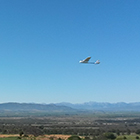Advancements & Achievements« Back to Advancements & Achievements Listings

SOUTH AFRICAN DATA DRONE INNOVATION PRIMED FOR GLOBAL EXPORT
By Rowan Philp
A South African start-up is rapidly emerging as the world’s most affordable and easy-to-use data drone system for agriculture, mining and topographical surveys.
Offering a turnkey ability to map and analyze crops and stockpiles from the air, Aerobotics is now rolling out its scalable commercial delivery phase following a successful pilot phase, and is expanding into African, Australian and ultimately western markets.
The company’s rapid growth this quarter includes half a dozen major commercial contracts with agriculture associations and mines, as well as the launch of a joint venture in Australia.
In South Africa: open cast mine managers who previously needed two days to measure the volume of their stockpiles – with men physically traversing the piles of ore, using $30,000 GPS devices – are measuring the volume with even greater accuracy in 10 minutes, using Aerobotics. They even have their stockpiles rendered in 3-D models on their computer dashboards.
And sugar farmers are able to intervene early to prevent 10 or even 20% crop failures via the system’s analytics suite, which harnesses the infra-red imagery to map regions and even individual crop rows of stressed plants.
The technology DNA behind the Aerobotics system – from its software platform to its data processing suite – can be traced to MIT, Imperial College London, and to a world-class South African team in the space, whose skill set includes electromechanical engineering, aeronautics, and even computational neuroscience.
But the disruptive potential lies in its unique affordability, and in its owner-operator model, in which an ordinary customer can hand-launch the fixed-wing drone, and then forget about it for an hour – and then simply place the returned drone in a wifi zone to upload data. The data automatically uploads to Aerobotics, and is available to the customer on their dashboard – fully processed and analyzed – the next day.
Company CEO James Paterson told SABLE that the company was now technically positioned to launch into the US and other western markets, and was seeking investment and technology partners to boost the expansion.
“We have multiple clients already using the system, and are really starting to take off on sales, having recently signed up some major partnerships,” says Paterson. “We expect the data contract numbers to ramp up dramatically in the coming months. We’d like to roll out into Australia, the US and South America – to do that, we need working capital to increase the size of our team, so we are looking to do a fund-raising round. We’ve put a lot of effort making ourselves automated, so we can handle scale internationally.”
He said hardware costs were roughly half that of the few global incumbents in the space, which would create room for rapid growth. “Our own hardware costs are lower than our competitors and we have an exchange rate advantage over rivals in the space, but we also specifically decided to keep the costs of the drones down, so that it is not a barrier to entry to this data field for any of our clients. Our recurring revenue comes from monthly data processing services.”
And while most western drone-and-data companies must fly separate flights for each data project, Aerobotics can perform multiple data gathering assignments in the same flight, using multiple cameras and a powerful data processing system.
Paterson said the company had decided to focus on agriculture, mining and logistics as target industries, due to their scale potential, and the unique value those customers enjoy. "In the agricultural space, we’re assisting farmers with detecting problems at a very early stage – and its proving to be such an effective solution that the crop associations are acting as resellers,” he says.

Remarkably: their system can detect chlorophyll levels and relative photosynthesis efficiencies between plants, using its imaging and data processing technologies.
But the firm has already demonstrated an astonishing diversity of applications.
Previously, the data system on its unmanned aerial vehicles (UAVs) has been used to count blue wildebeest in the Serengeti, to survey land, and to disrupt nocturnal poaching.
Having fine-tuned the software suite in the first quarter, the transition to commercial sales was signaled with the hiring of Andrew Burdock as Commercial Director this summer – an MBA finance and sales strategy expert who previously lead the new product development team at security giant ADT. Burdock told SABLE: “Its so exciting to be involved at the cutting edge of a new industry. When the founders first showed me what the platform could do – it was unbelievable; groundbreaking. It is fantastic that a South African team is designing systems at pace with the guys in Silicon Valley.”
Launched in 2014, Aerobotics was born from a pure passion for innovation among a core group of young South African engineers. Following a BSc in mechatronics at the University of Cape Tow, Paterson – who later co-founded the company with neurotechnologist Benji Meltzer – received a master’s degree in Aeronautics and Astronautics at MIT. His research focus was artificial intelligence, and autonomous UAVs for search-and-rescue.
His leadership team includes one electro-mechanical engineer who once developed a remote-controlled vehicle to exercise cheetahs, and a data engineer who obtained an MSc in neurotechnology at Imperial College, London. "This is such an exciting field,” says Paterson. “We are innovators here, with product which we feel is the best out there; we are working on technology that we love. We are looking for potential partners in the SABLE network to expand to new markets. Our clients are largely in South Africa at present, but we’ve had a lot of requests from neighboring countries and abroad.”
“The demand is really taking off,” he says. “The nice thing about our business plan is we sell the hardware – the drones – to the client, anywhere in the world, but the data processing is done in the cloud using Aerobotics software. So its really easy to scale.”
Taking advantage of South Africa’s weakened exchange rate, the team plans to leverage its unique value proposition for clients, based on low-cost, versatility and ease-of-use. “We provide our clients with the complete UAV solution that includes the hardware, and the data processing and software solutions to get actionable data they need for their businesses,” he says. “All our costs are so much lower than in the U.S. and Australia, partly due to the exchange rate, and we are looking to leverage the currency and cost advantage we have over western companies.”
“We are cheaper than many U.S. companies; the drones we provide are among the very few fixed-wing and multi-rotor options that carry multiple cameras. So, in one flight, we can provide a whole variety of data, on visual maps, contour maps, per-tree health; you name it. Most others need to swap the camera out.”
Pioneering software development at the firm includes simple, color-coded graphic analysis. “For agricultural clients, for example, we make the data really easy to interpret – so red is bad, green is good,” he says. “And we have written some things to make it even easier – on our plant health indices, we’ve written an algorithm which works on a per-tree basis. So you’ll see a circle above your tree, and that circle will be red, orange or green, indicating the health status of that tree. We use new infrared cameras to fill out that picture.”
Of its three UAV platforms, the AeroHawk has emerged as the primary data workhorse for most clients. Clients simply hand-launch this fixed-wing drone – and then forget about it, as it gathers data and flies GPS-based grid patterns for the next 90 minutes, before landing on its own, without the need for a runway.
Later, the client simply plugs the drone into a computer port, and the data is automatically transmitted to Aerobotics. Here, data processing software produces actionable data for the client from that flight, which is accessed via a digital dashboard.
Paterson says: “It’s a very reliable platform – it can do terrain following, using Google Earth terrain data to go over mountains. For instance. We set up geo-fences as well; if it goes outside fence or runs low on battery power, it will return to home.”
Paterson says the data platform also presents an important potential tool for solving humanitarian challenges; perhaps, he says, the kind of challenges presented by CauseTech. (http://causetech.net/). A dynamic collaboration between UNICEF and the Chief Marketing Officer (CMO) Council, CauseTech challenges innovators and entrepreneurs globally to leverage their technology solutions to address critical problems facing the world’s most vulnerable children.
He says: “We have already been talking to people about potentially becoming involved in the malaria fight in Africa – specifically, on helping authorities know how many resources, like mosquito nets, to send where; or even something as simple as counting rural homes. You can potentially even detect where mosquitoes are breeding, using thermal imaging. Ultimately – with further advances in automation – you could see UAVs detecting hotspots where mosquito larvae are breeding, where they are able to use data to decide to investigate more closely.”
Paterson says Aerobotics is seeking to develop overseas partners as it expands in the second half of 2016, including resellers, technology partners and investors.
“We do have a very effective product ready – so an investment of, say, $700,000 would go a long way for us here in South Africa; scaling up our software team and our data team, and boosting the marketing side,” he says.
Paterson says potential applications for the platform include everything for consumer goods delivery to infrastructure surveys.
As an engineer, Paterson still hopes – when regulations allow – to one day develop fully autonomous UAVs: drones capable “of making decisions based on data it collects during the flight.” But he sees the data processing revolution as equally profound, and one that is already showing extraordinary return on investment for increasingly data-smart businesses.
More on Aerobotics can be found at http://aerobotics.co.za/

